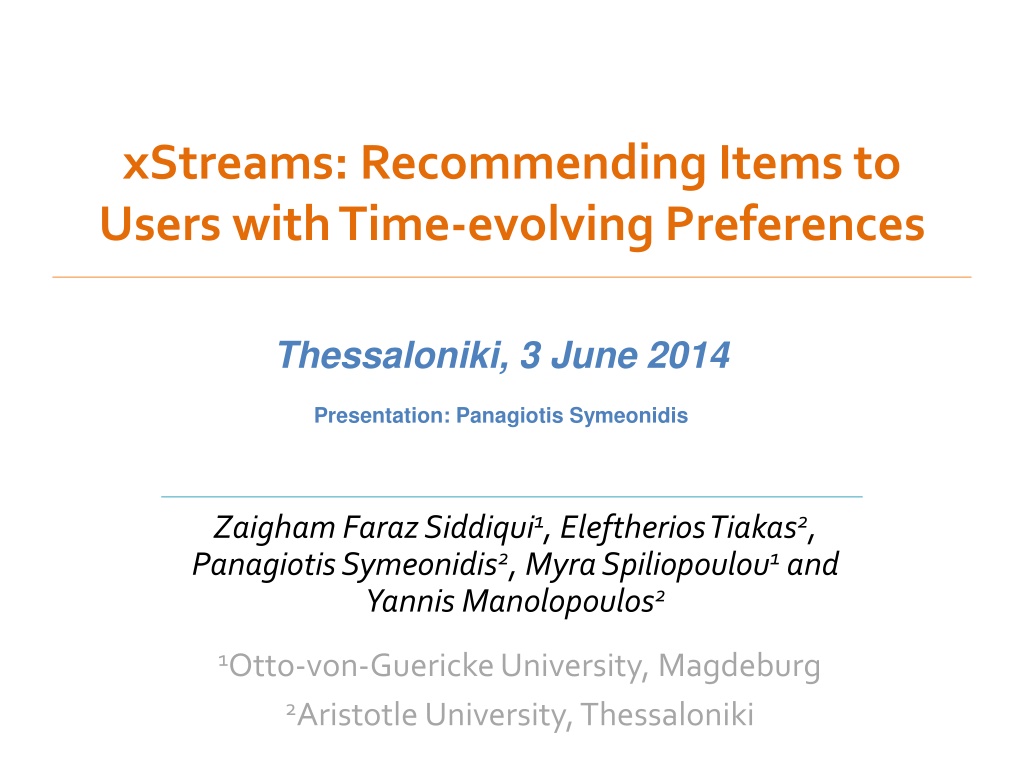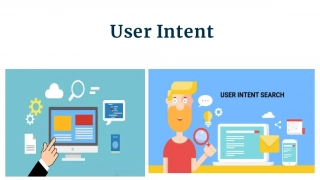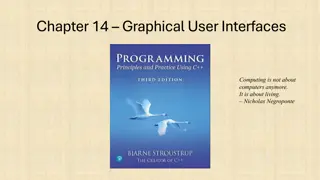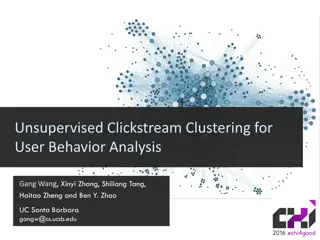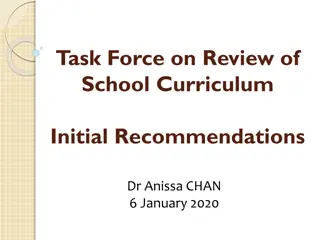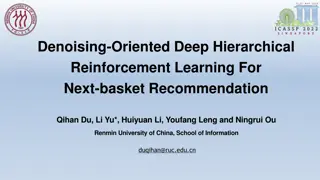Enhancing User Experience Through Dynamic Recommendations
In this presentation, the xStreams system is introduced for recommending items to users with changing preferences. The methodology involves learning user preferences, finding similar users, and providing item recommendations. The motivation behind the system includes dealing with vast amounts of data and addressing concept drift in user preferences over time. The presentation also discusses recommender systems and their role in suggesting items based on collaborative or content-based filtering. Overall, the focus is on leveraging relational data and adapting to evolving user interests for enhanced recommendation accuracy.
Download Presentation

Please find below an Image/Link to download the presentation.
The content on the website is provided AS IS for your information and personal use only. It may not be sold, licensed, or shared on other websites without obtaining consent from the author. Download presentation by click this link. If you encounter any issues during the download, it is possible that the publisher has removed the file from their server.
E N D
Presentation Transcript
xStreams: Recommending Items to Users with Time-evolving Preferences Thessaloniki, 3 June 2014 Presentation: Panagiotis Symeonidis Zaigham Faraz Siddiqui1, Eleftherios Tiakas2, Panagiotis Symeonidis2, Myra Spiliopoulou1and Yannis Manolopoulos2 1Otto-von-Guericke University, Magdeburg 2Aristotle University, Thessaloniki
Outline Introduction Problem Definition Motivation RelatedWork Our Method Learning User s Preferences FindingSimilarUsers Item Recommendation Evaluation Evaluation Issues Experimental Results Conclusion 29.09.2024 xStreams 2
Huge amount of data... YouTube receives 72 hrs of video content per minute. 20 novels are published each hour in English. There are approx. 18,000 restaurants in New York. What to see? What to read? Where to dine? 29.09.2024 xStreams 3
Recommender Systems Recommenders can help users by suggesting to them items of their preference You should see Game of Thrones. I am sure you lllike it. 29.09.2024 xStreams 4
Recommender Systems Items can be suggested to a user because they are: either liked by similar users (Collaborative Filtering) or are similar to the items that s/he likes (Content-based Filtering) Hybrid approaches use a combination of both 29.09.2024 xStreams 5
Motivation 1 -Recommendations over Relational Data E-shops stored data using relational DBMS. Information about the items, the users and their ratings on items is stored in a neighboring relation. Thus, information on user's preferences can be derived also from the properties/attributes of the items that s/he likes. name rates category size color Ratings price 29.09.2024 xStreams 6
Motivation 2-Concept drift over a stream of relational data Preferences of a user are dynamic. Users may develop a liking for newer items over time, while s/he may stop liking what s/he used to prefer earlier. Tom&Jerry Game of Thrones Mickey Mouse Star Wars Milk Beer grows older John @ 5 years John @ 20 years 29.09.2024 xStreams 7
Related work of Stream Recommenders Method of [Nasraoui et al., SDM 2007] TECHNO-Streams predicts the nextweb page in a user session. Itis adaptive methodandis based on clustering. However, forgetinga usersession is unintuitive. Method of [Diaz-Aviles et al., RecSys 2012] SRMF performsMatrix Factorizationanditem ranking overa stream. However, the algorithm itself is not adaptive because it requiresthe matrixdimensions tobe knownin advance. 29.09.2024 xStreams 8
Our xStreams algorithm It uses propositionalization/aggregation to merge multiple streams in a single one. It is a hybrid approach. It uses content-based filtering to learn a user's preference via items properties. It exploits users ratings on items to find a set of similar users (collaborative filtering). It uses a window to store only the most recent ratings (forgetting the past ratings) It adapts when the user's preferences change. 29.09.2024 xStreams 9
Learning User's Preferences xStreams makes use of propositionalisation which converts many relational streams into a single stream. Multiple rated items of users are summarized to a propositionalised vector . stores all the information about the items that likes during last timepoints, i.e., from to . 29.09.2024 xStreams 10
Example of Propositionalisation 29.09.2024 xStreams 11
FindingSimilarUsers (1/2) Content-based similarity over prop. stream user , we perform content-based filtering with others by using cosine similarity. t u t v e . e . = simCB ( t , u , v ) t u t v e e Collaborative filtering over user-item matrix user , we compute collaborative filtering with others by using the cosine similarity. u t , ,. r r , u i v i i I I = ( , , ) simCF t u v , t v ( ) u r ( ) v r I i I i 2 2 , , i i u , , t t v 29.09.2024 xStreams 12
FindingSimilarUsers (2/2) xStreams computes a hybrid similarity between users. The final similarity is acquired as a weighted similarity that is based on and = + , ) * , ) simTotal(t ,u v * a simCB(t, , , v 1 ( a) simCF(t u v) 29.09.2024 xStreams 13
Recommending Items (1/2) 1. xStreams sorts the users similarity based on similarity. 2. It selects considered as most similar to user who are 3. The items from the potential recommended items. can serve as 29.09.2024 xStreams 14
Finding Items to Recommend(2/2) 4. The final predicted rating of a user u for an item + = j u avg r , ( , , ) simTotal t u v r r , v j j v v ( , , ) simTotal t u v 5. The items are sorted according to the computed predicted ratings and the recommended to . items are 29.09.2024 xStreams 15
Evaluating a Stream Recommender How long does the future span for a user? In hold-outevaluation, a subset of newly arrived objects is reserved only for evaluation. (It assumes that we can predict all future with the past ratings and no concept change occurs) This violates the stream mining assertion that changes do occur!!! In prequentialevaluation, new objects are first evaluated and then are used for model learning. (It assumes that all objects appear in the next time batch ) How to handle a user who appears once or occasionally? 29.09.2024 xStreams 16
Evaluating a Streaming Recommender We use a version of prequential evaluation with hold-outs. We split the data from the into At , test data from gets incorporated into train. and . Old ratings are forgotten A portion of ratings in a batch is used for hold out and the rest for prequential evaluation 29.09.2024 xStreams 17
Evaluation Datasets MovieLens (hetrec2011-movielens-2k) 2113 userswho rated 10197 movies (+genre, actors,tags, etc.) 140 monthsperiod. User Rating Genre Movie Actors Synthetic Dataset Created using MultiGen (Siddiquiet al., MUSE 2011) Simulates the rating behavior of users and concept drift User Rating Item 29.09.2024 xStreams 18
Evaluation Datasets: Statistics [MovieLens] There is increase ofcold start items at t80. [MovieLens] There is concept shift at t80, i.e., global change in average rating of the rated items. [Synthetic] There is concept shift at t10. 29.09.2024 xStreams 19
Evaluation Framework Evaluation Strategies xStreams with weights for & CFStream Evaluation Measures Precision, Recall & RMSE Parameters MovieLens: Synthetic: 29.09.2024 xStreams 20
Experimental Results MovieLens time 29.09.2024 xStreams 21
Experimental Results Synthetic time 29.09.2024 xStreams 23
Experimental Results Synthetic time 29.09.2024 xStreams 24
Conclusion We have presented a hybrid recommender for stream data, which combines CB filtering with CF. xStreams runs over a single combined stream of multiple relational streams. It adapts adequatelyin concept drift. We have outlined the challenges in the evaluation of streaming recommenders. 29.09.2024 xStreams 25
Future work There is a need for an evaluation framework that alleviates the drawbacks of prequential evaluation. Our datasets used in experiments follow power-law distribution. That is, there are users with many ratings on few items (Big Head), but many users with few ratings on different items (Long Tail). We want to develop measures that can capture the notion of similarity for the users of the Long Tail by incorporating serendipity in our item recommendations. 29.09.2024 xStreams 26
Thank You! ? Questions ? ? 29.09.2024 xStreams 27
Acknowledgements Part of this work was funded by the German Research Foundation project SP 572/11-1 "IMPRINT: Incremental Mining for Perennial Objects". 29.09.2024 xStreams 28
